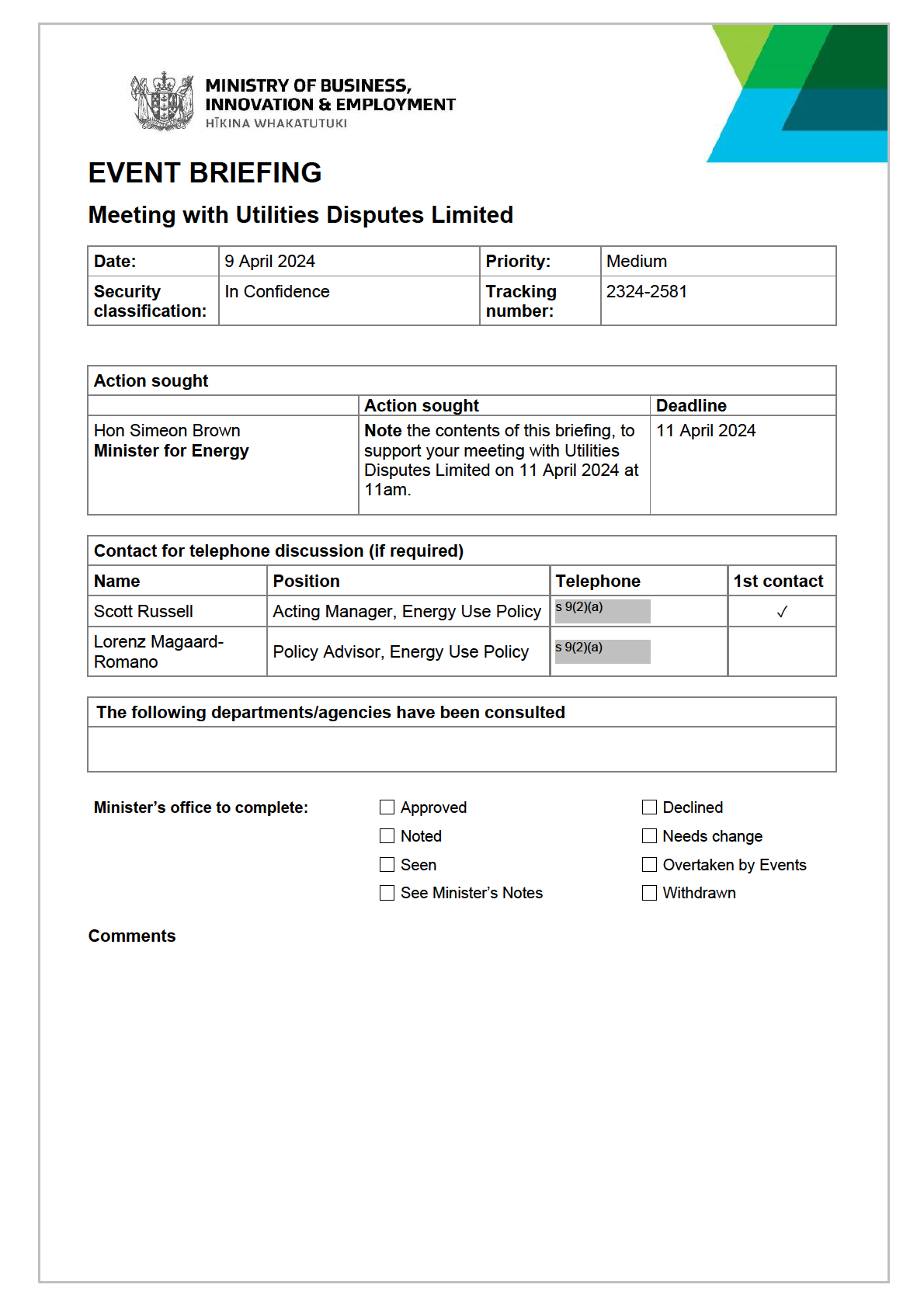
the 1982
Act
under
Released
Information
Official

 EVENT BRIEFING
Meeting with Energy Disputes Limited
Date:
EVENT BRIEFING
Meeting with Energy Disputes Limited
Date:
9 April 2024
Priority:
Medium
Security
In Confidence
Tracking
2324-2581
classification:
number:
Purpose
To provide background information and talking points for your meeting with Utilities Disputes
Limited on 11 April 2024 from 11 am to 11:30 am.
Recommendations
the 1982
The Ministry of Business, Innovation and Employment (MBIE) recommends that you:
a
Note the contents of this briefing, to support your meeting with Utilities Disputes Limited.
Act
Noted
under
Acting Manager, Scott Russell
Hon Simeon Brown
Energy Use Policy
Minister for Energy
Building, Resources and Markets, MBIE
..... / ...... / ......
Information
09/04/2024
Released
Official
2324-2581
In Confidence
1
Meeting purpose and logistics
Date:
11 April 20204
Time:
11:00am-11:30am
Location:
EW 5.1
Hon Heather Roy, Chair, Utilities Disputes Limited
Attendees:
Neil Mallon, Commissioner, Utilities Disputes Limited
Attendee biographies are included at
Annex One.
1.
Utilities Disputes Limited (UDL) have requested this meeting to discuss the five-year
independent review of the complaints scheme for electricity and gas providers. They have
indicated they would like to discuss the following topics specifically:
•
the UDL Board’s response to the recommendations from the review
•
matters from the report that are relevant to the energy portfolio, in particular the
expansion of the complaints scheme jurisdiction to include new energy sources such
the
as solar.
1982
2.
UDL is an important part of the energy market regulatory structure, and this meeting provides
you with an opportunity to discuss how UDL can help you achieve your goals in this space.
Act
3.
UDL runs an independent energy disputes resolution scheme, the Energy & Gas Complaints
Scheme, approved under the Electricity Industry Act 2010 (the Act). There are 368 scheme
participants. UDL, and its predecessor the Office of the Electricity and Gas Complaints
under
Commissioner, has been handling energy complaints since 2001, operating as a free dispute
resolution service for consumers. The number of energy complaints received by UDL is
increasing. In 2023 they received 4,468, which is up 21% on the previous year. It is funded
by a combination of membership and complaint fees levied on participants.
4.
Under the Act, electricity retailers, distributors and Transpower are required to be members
of the dispute resolution scheme. The Minister of Commerce and Consumer Affairs is the
Minister responsible for the approval of UDL as the dispute resolution scheme provider under
the Act, as well as approval of the scheme’s rules.
5.
The Minister of Commerce and Consumer affairs was also provided with a copy of the
Released
Information
independent review. The Minister was not able to meet with UDL but provided a written
response which can be found in
Annex Four.
6.
UDL also operates three other dispute resolution schemes:
•
the government-approved Broadband Shared Property Access Disputes Scheme
•
a voluntary Water Complaints Scheme
•
a voluntary Telecommunications Service for broadband and mobile services.
Official
7.
The remainder of this briefing provides background information and talking points to support
your meeting with UDL in relation to your energy portfolio.
2324-2581
In Confidence
2
Independent Review of Energy Complaints Scheme
Out of scope
the 1982
Act
under
Released
Information
Official
2324-2581
In Confidence
3
Out of scope
UDL’s jurisdiction in relation to solar and other emerging technologies
15. Consumers do not have access to a free dispute resolution scheme for some emerging
technologies. UDL has raised concerns regarding the scope of their jurisdiction in the
evolving energy sector and believes this scope should be expanded for the scheme to
remain fit for purpose.
16. For example, UDL cites that they are regularly contacted by consumers who have concerns
about solar providers that they are often unable to consider. UDL is only able to consider
these complaints if the company that sold and installed the solar is connected to the
provision of traditional energy services (such as retail, distribution, and transmission
services). Similar issues may exist with other emerging technologies.
17. Consumers have some options for addressing complaints in these areas: they may be able
the 1982
to complain to the Sustainable Energy Association of New Zealand (SEANZ) which can
investigate claims made against its members, however, SEANZ is a voluntary industry body
and not all solar installers are SEANZ members. If there have been general breaches under
existing legislation such as the Fair Trading Act 1986, consumers can take their complaints
Act
to the Disputes Tribunal or District Court, or make a complaint to the Commerce Commission
if appropriate. However, UDL sees these as unsatisfactory. They believe they are costly and
time consuming for consumers and that most consumers are not well equipped to manage
under
this process without advocacy support.
18. The number of consumers using new technologies such as solar is expected to increase as
New Zealand further electrifies. Electricity Authority figures show more than 53,000
residential ICPs now have solar power behind the meter and that number is growing, with
close to 600 new installs each month.
19. The Australian Energy Regulator has taken action in this area, publishing a consultation
paper in 2022 seeking feedback on options to reform the National Energy Consumer
Framework. However, we note that the Australian Government ran significant programs
Information
(such as subsidies) to push for the increased use of solar, which resulted in higher
Released
installation rates than we have seen in New Zealand to date.
20. The jurisdiction of the Energy Complaints Scheme and the wider regulatory regime is
specified in the Act. Any changes to the jurisdiction would require amendment legislation.
s 9(2)(g)(i)
Official
21. Suggested talking points:
2324-2581
In Confidence
4

the 1982
Act
under
Released
Information
Official

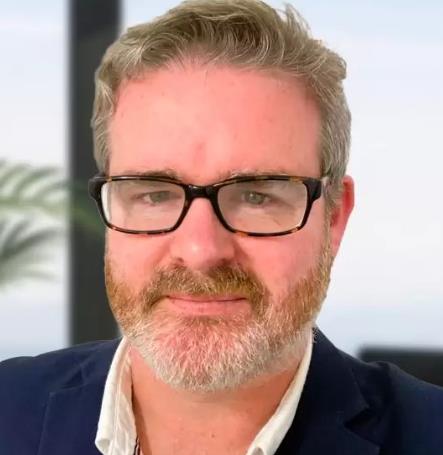 Annex One: Attendee biographies
Hon Heather Roy, Independent Chair
Annex One: Attendee biographies
Hon Heather Roy, Independent Chair
Heather has served on the Board since 2014.
She was a Member of Parliament from 2002 –
2011, including Minister of Consumer Affairs
(2008-2010). She is a professional director,
chairing several boards, and principal and
director of boutique consulting company
TorquePoint Ltd. Heather is also invited to
commentate on political forums on radio and
TV.
Heather is also Chair of the Electricity
Authority’s Security and Reliability Council
which provides independent advice on
reliability of supply issues, the performance of
the electricity system and the system operator.
the 1982
Neil Mallon, Commissioner
Neil became UDL’s commissioner in
December 2023 after 3 years as deputy
Act
commissioner. He is a lawyer with extensive
experience in complaints and regulation.
under
Before joining UDL, Neil worked in Senior and
General Manager roles and at executive team
level for national regulatory organisations.
Released
Information
Official
2324-2581
In Confidence
6
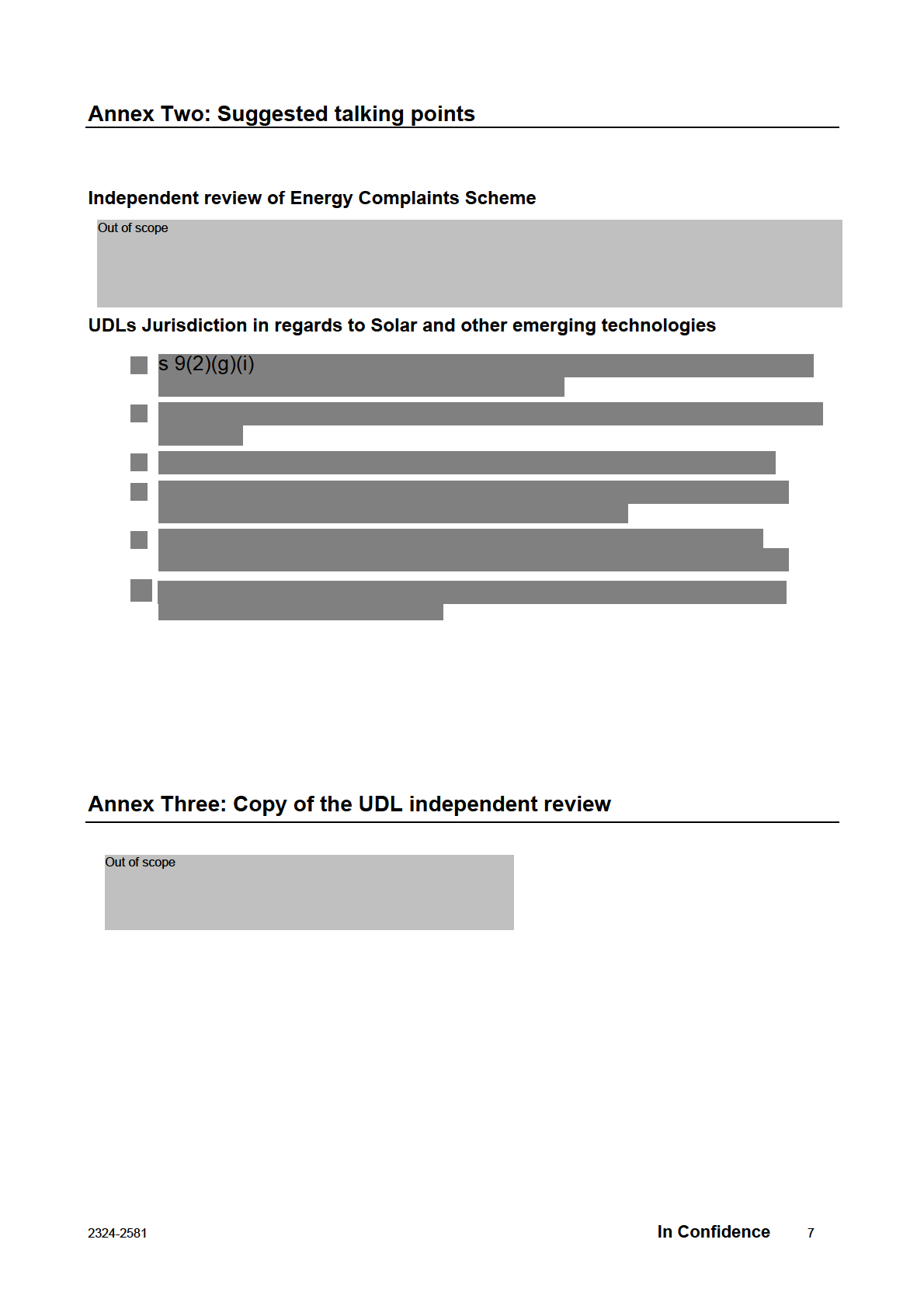
the 1982
Act
under
Released
Information
Official
Annex Four: Minister of Commerce and Consumer Affairs response to
UDL
Out of scope
the 1982
Act
under
Released
Information
Official
2324-2581
In Confidence
8
 EVENT BRIEFING
EVENT BRIEFING
Meeting with solarZero and Aurora Energy
Date:
16 May 2024
Priority:
Medium
Security
In Confidence
Tracking
2324-2597
classification:
number:
Action sought
Action sought
Deadline
Hon Simeon Brown
Note the contents of this briefing
23 May 2024
Minister for Energy
ahead of your meeting with
the
solarZero and Aurora Energy on 23
1982
May 2024
Contact for telephone discussion (if required)
Act
Name
Position
Telephone
1st contact
Manager, Electricity Generation,
9(2)(a)
Tamara Linnhoff
Infrastructure and Markets Policy
under
Policy Advisor, Electricity Generation,
Maryam Bukhari
–
Infrastructure and Markets Policy
The following departments/agencies have been consulted
Minister’s office to complete:
Approved
Declined
Noted
Needs change
Released
Information
Seen
Overtaken by Events
See Minister’s Notes
Withdrawn
Comments
Official
 EVENT BRIEFING
EVENT BRIEFING
Meeting with solarZero and Aurora Energy
Date:
16 May 2024
Priority:
Medium
Security
In Confidence
Tracking
2324-2597
classification:
number:
Purpose
This briefing provides you with background information and suggested talking points ahead of your
meeting with solarZero and Aurora Energy on 23 May 2024 at 4:00pm.
Recommendations
the 1982
The Ministry of Business, Innovation and Employment recommends that you:
a
Note the contents of this briefing ahead of your meeting with solarZero and Aurora Energy on
23 May 2024.
Act
Noted
under
Tamara Linnhoff
Hon Simeon Brown
Manager, Electricity Generation,
Minister for Energy
Infrastructure and Markets Policy
Building, Resources and Markets, MBIE
..... / ...... / ......
16 / 05 / 2024
Information
Released
Official
2324-2597
In Confidence
1
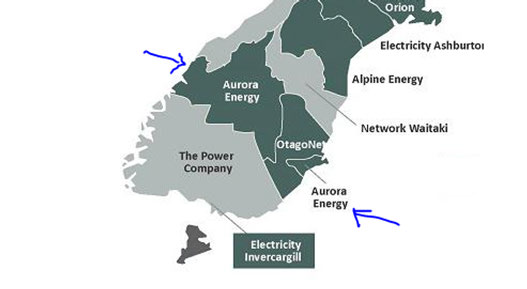 Meeting purpose and logistics
Date:
Meeting purpose and logistics
Date:
23 May 2024
Time:
4:00 pm
Location:
Your office
Andrew Booth, Founder and Chair, solarZero
Matt Ward, Chief Executive Officer, solarZero
Eric Pyle, Director Public Affairs and Policy, solarZero
Attendees: Richard Fletcher, Chief Executive Officer, Aurora Energy
Mark Pratt, General Manager Customer and Connections, Aurora Energy
Glenn Coates, General Manager Asset Management and Planning, Aurora Energy
Attendee biographies are included at
Annex One.
1.
solarZero and Aurora Energy (Aurora) requested this meeting to discuss:
Their joint non-network solar and battery capacity projects in Queenstown and Upper
Clutha area, opportunities for further cost savings by networks and related electricity
issues
the 1982
international examples of non-network solutions, from the United States of America
(USA) and Australia, where distributed energy resources (DER) were utilised to defer
network upgrades
their request for government agencies to support innovation and col aboration.
Act
2.
This meeting also provides an opportunity for you to discuss the opportunities for better use
of DER to support security of supply and manage winter peaks, such as the tight supply
under
situation that occurred on 10 May 2024.
3.
solarZero is an instal er (and owner) of residential solar photovoltaic panels (solar) and
batteries with approximately 12,000 residential customers in New Zealand. solarZero
provides the technology in partnership with Panasonic and it is owned by BlackRock Real
Assets (BlackRock).
4.
solarZero has two non-network solutions in Upper Clutha and Coromandel Peninsula. It is
the world’s first solar and battery storage provider to offer into the reserve market its batteries
operating as a virtual power plant (VPP)1. Its batteries can be dispatched by Transpower as a
peaker plant.
Information
5.
Aurora is one of New Zealand’s
Released
largest electricity distribution
business (EDB) with over 200,000
customers across Dunedin,
Central Otago, Wānaka and
Queenstown. Aurora comprises
two separate distribution networks
as shown below:
Official
1 A VPP is aggregation of solar panels and batteries located in different places connected to the grid to
generate, store, and provide energy as and when needed.
2324-2597
In Confidence
2
6.
Aurora is owned by Dunedin City Council (DCC), through Dunedin City Holdings Limited.
DCC is considering the possibility of selling Aurora and is currently consulting publicly before
making a final decision in May or June this year.
7.
The remainder of this briefing provides background information and suggested talking points
on these topics are included in
Annex Two.
8.
In the context of the Electrify NZ work programme, your office recently asked for information
on solar / battery tech and how it works in the NZ market, and in particular background
information on solar and battery uptake, trials and market arrangements. This information is
included in
Annex Three.
solarZero’s non-network (solar and battery capacity) projects
solarZero’s non-network (solar and battery capacity) project in Queenstown and
Upper Clutha
9.
In 2020, after a tendering process, Aurora partnered with solarZero to provide non-
the 1982
exclusive, non-network capacity support in the Upper Clutha region. This was the first time
that Aurora had tendered via an open market for non-network solutions.
10. Under this partnership, solarZero is instal ing solar and battery storage on Aurora’s
customers’ properties in Queenstown and Upper Clutha. solarZero’s system enables it to
Act
coordinate the charging and discharging of individual batteries to manage peak network
demand in those areas. Managing individual consumers’ demand in this way is cal ed a
‘non-network alternative’. It avoids or defers the network investment otherwise needed to
under
meet Aurora’s growing peak demands in those areas driven largely by tourism and
irrigation.
You could ask:
How much does a typical customer save if they have a solar and battery through
solarZero?
Trial with Ara Ake for virtual power plant to manage winter peak
11. Last winter, Ara Ake and solarZero developed the Winter Peak Innovation Pilot to trial
aggregating solarZero’s 10,000 residential batteries as a VPP to contribute to the national
Released
Information
grid during winter peak. They worked with Transpower and the Electricity Authority to
successful y onboard into Transpower’s system. Ara Ake provided funding of up to $4 mil ion
and SolarZero contributed $10 mil ion (MBIE is the funding source for Ara Ake).
12. Up to 30 MW of controllable load was made available by solarZero as part of its Ara Ake-
funded trial. On Friday 10 May 2024, solar Zero also contributed 30MW via the VPP to
national electricity supply.
13. During the 2023 trial, solarZero faced chal enges in controlling and aggregating batteries
Official
located at multiple grid exit points (GXPs) due to the need to comply with the Electricity
Industry Participation Code 2010 (the Code), grid voltage regulations, aggregation
constraints, and customer enquiries.
14. As a result of the pilot, the Electricity Authority amended the Code to reduce barriers to
participation for services that aggregate such resources.
2324-2597
In Confidence
3
You could ask:
What insights did you gain from last Winter Peak Innovation Pilot, and wil solarZero
offer it or trial it again in winter 2024?
Are there any outstanding barriers to the use of solarZero’s VPP to help manage tight
supply situations?
What did solarZero do with its DER systems on the morning of 10 May?
As the electrification of the New Zealand transport fleet increases, what role do you see
for EVs to support electricity supply in periods of high demand?
International examples of non-network solutions
15. solarZero would like to talk to you about the following international examples of non-network
solutions, where distributed energy resources (DER) were utilised to defer network upgrades.
Brooklyn-Queens Demand Management program in USA the 1982
16. The Brooklyn-Queens Demand Management Program began as a trial in 2014. It used
aggregated distributed energy resources (DER) – for example, solar, batteries and electric
vehicles – to manage anticipated shortfall in two substations in densely populated areas of
Brooklyn and Queens, New York.
Act
17. It deferred a $1.2 bil ion substation upgrade. By the end of September 2023, 61 MW of peak
hour load relief was achieved, using approximately $131 mil ion of an approved $200 mil ion
under
budget.
18. New Zealand’s first similar DER project was undertaken by Vector in 2015/16 using batteries
at its Epsom Zone Sub-Station. It was designed to delay upgrades to the substation to meet
increased consumer demand. It proved to be a cost-effective alternative to delay network
expenditure.
Australia’s Project EDGE
19. Project EDGE (Energy Demand and Generation Exchange) was a research trial funded by
the Australian Renewable Energy Agency. It provided insights into opportunities and barriers
Information
to DER integration and key considerations for policy development and reforms.
Released
20. The Project highlighted that consumer-centric approaches are crucial for successful
integration of DER. This includes communication and data transparency, helping consumers
understand how VPP works, providing incentives to consumers to join VPPs, and providing
consumers choices to join various programmes.
Official
2324-2597
In Confidence
4
Funding for distributed flexibility resources
21. It is likely that solarZero may ask about funding opportunities from the Government. Possible
funding options from the Ministry of Business, Innovation and Employment (MBIE) are the
Community Renewable Energy Fund and Distributed Flexibility Innovation Fund. This latter
fund was announced by the last government but has not been launched, pending Budget
2024 decisions.
Community Renewable Energy Fund
22. MBIE’s $46 mil ion Community Renewable Energy Fund (CREF) was launched in 2022 to
enhance energy resiliency in communities and trial innovative ways to store and distribute
locally generated electricity.
23. The design and delivery of the CREF was announced in September 2023. It included $6.5
mil ion for solar and battery systems on approximately 60 community buildings in regions
affected by Cyclone Gabriel e and other severe weather events.
24. These community resilience sites wil receive grant funding to install solar and battery
the 1982
systems to support their resiliency and recovery. Officials are currently working with the
selected site owners to execute contracts for the solar and battery. Some sites are already
operating and most systems are expected to be instal ed and operational by mid-2024.
25. Post-confirmation of Budget 2024 decisions, officials wil provide you with advice on the
Act
future delivery options of the remaining CREF funding in line with your priorities.
under
You could say:
I have already approved up to $6.5 mil ion of funding for community resilience sites in
regions affected by 2023 severe weather. I am continuing to take advice from officials on
delivery options of the Community Renewable Energy Fund.
You could ask:
Keeping the lights on is a top priority and I am interested in the potential of distributed
energy resources to support security of supply during winter peaks. What are your views on
how the Community Renewable Energy Fund could best support the development of
distributed energy resources?
Information
Distributed Flexibility Innovation Fund
Released
26. The Distributed Flexibility Innovation Fund (DFIF) was announced in September 2023 by the
previous government to support DER trials. The fund was al ocated a total of $20 mil ion over
4 years via Budget 2023, was to be run by Ara Ake, and attracted substantial stakeholder
interest including from solarZero and electricity networks.
27. The DFIF was designed to co-fund innovative industry-led and collaborative trials to show the
benefits of DER in enhancing both security of supply and affordability. DER can help balance
Official
the wholesale electricity market (shifting demand away from peak periods) and avoid or defer
costly network investment (lowering costs for all consumers).
28. In December 2023 we briefed you on the role of the DFIF [refer 2324-1128] seeking your
agreement to open the fund to expressions of interest for its first funding year (starting in
early 2024). The DFIF work remains paused pending confirmation of Budget 2024 decisions.
2324-2597
In Confidence
5
If solarZero mentions DFIF, you may like to note:
Any statements about the Distributed Flexibility Innovation Fund wil need to wait until
after Budget Day.
2025 reset of default price-quality path regulation
29. Aurora is one of the 16 EDBs subject to a default or customised price-quality path
(DPP/CPP). A price-quality path determines the maximum revenue EDBs can recover from
its consumers and the required quality standards. Aurora is currently the only EDB on a CPP,
which it applied for to address historic under-investment that was evidenced by numerous
pole failures (including one causing a fatality). Aurora’s CPP runs from 1 April 2021 to 31
March 2026, and it wil return to a DPP from 1 April 2026 unless it applies for a new CPP
before then.
30. In December 2023, Aurora applied to the Commerce Commission (Commission) for a ‘re-
opener’ - to re-open its CPP for the period to April 2026 - for reasons including ‘[t]
he first two
years of our CPP has demonstrated that demand for electricity has continued unabated, as
has the demand for new connections.’
the 1982
31. Aurora’s application seeks to cover an additional $46.3 mil ion in capital spending, across the
remainder of the CPP period (to 2026). This is to enable extra capacity-related investments
that were not forecast when the CPP was initially determined in 2021. $26 mil ion of the
extra spending sought is earmarked for consumer connection capex. Aurora says this is
Act
necessary to keep up with connections and upgrades driving network growth, while avoiding
an “inequitable wealth transfer” from existing to new customers.
under
32. In its application, Aurora noted that reconsideration of their CPP is not expected to have any
impact on consumer prices before 31 March 2026.
33. Aurora runs three pricing regions to recover its allowable revenue. Aurora’s approach aims to
al ocate the cost of investments to the pricing region in which the investment is required. On
this basis, with four of the five reconsideration projects occurring within the Central
Otago/Wānaka pricing region, along with a substantial share of consumer connection
investments, the incremental price impact would be highest in that pricing region.
You could ask:
Information
What insights has Aurora gained from the non-network solutions implemented in
Released
Queenstown and the Upper Clutha areas, and do you have plans to seek non-network
solutions to avoid or defer network expenditure in other areas?
Has Aurora explored accessing the innovation investment pathways for greater use of
non-network solutions with the Commerce Commission?
Aurora has applied to the Commerce Commission for the customised price-quality path
(CPP) to be re-opened. How wil this requested additional funding contribute to using
DER to support security of supply?
Official
How does Aurora plan to mitigate the impact or step changes of price increases for
customers?
Risks and mitigations
34. We have not identified any specific risks associated with this meeting.
2324-2597
In Confidence
6
Annexes
Annex One: Attendees’ biographies
Annex Two: Suggested talking points
Annex Three: Background material on solar and battery uptake, trials and market arrangements
the 1982
Act
under
Released
Information
Official
2324-2597
In Confidence
7
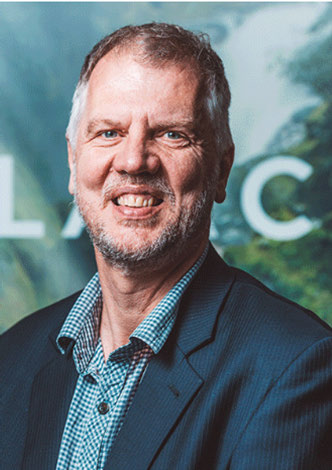

 Annex One: Attendees’ biographies
Andrew Booth, Founder and Chair, solarZero
Annex One: Attendees’ biographies
Andrew Booth, Founder and Chair, solarZero
Up until 2019, Andrew was CEO of solarZero.
In 1991, Andrew founded World Television which is
Europe’s longest established virtual and hybrid events
technology agency in Europe and Asia, and he was the
Director of the company. Prior to this, Andrew was the
International Board Director for Greenpeace
International.
Matt Ward, CEO, solarZero
Before becoming CEO in August 2023, Matt was Chief
the 1982
Financial Officer and Chief Operations Officer.
Prior to that, Matt was CFO at Oceania Healthcare –
retirement vil age.
Act
under
Eric Pyle – Director Public Affairs and Policy,
solarZero
Eric Pyle has been working as a Director Public Affairs
& Policy at solarZero since August 2018.
Eric has worked in a wide range of sectors including
environmental management (water, biodiversity, and
climate change), energy, outdoor access, policy,
science, external relations, and communications. Eric
was Chief Executive Officer (CEO) at New Zealand
Released
Information
Walking Access Commission Ara Hīkoi Aotearoa (2016-
2018) and also at NZ Wind Energy Association (2011-
2018). He was also a Director of Environmental and
Social Development at Ministry of Research, Science
and Technology (2003-2011).
Eric’s career spans government, industry, business,
research and NGO sectors. Eric had roles with Forest &
Bird, WWF and the central government natural
Official resources sector.
2324-2597
In Confidence
8

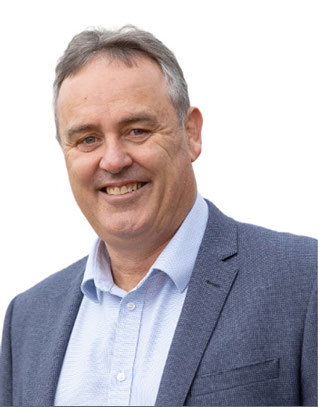
 Richard Fletcher, CEO, Aurora Energy
Richard Fletcher, CEO, Aurora Energy
Before becoming CEO at Aurora Energy Limited in
January 2018, Richard was General Manager
Regulation and Corporate Affairs at Powerco.
Prior to that, Richard was Regulatory Strategy Manager
at Transpower. From 2000 to 2005, Richard was Head
of Economic Regulation at Welsh Water, UK.
Richard has extensive international experience in
engineering and management consulting. He has
advised on energy regulation, asset management, due
diligence studies for mergers and acquisitions, as wel
as engineering investment plans.
Mark Pratt, General Manager Customer and
Connections, Aurora Energy
Mark joined Aurora Energy in 2018 and was appointed
General Manager Works Programming and Contracts in
December 2018.
the 1982
Before joining Aurora Energy, Mark was Electricity
Contracts and Performance Manager at Powerco.
Mark has more than 30 years’ experience in contract
management and service delivery.
Act
under
Glenn Coates, General Manager Asset Management
and Planning, Aurora Energy
Glenn joined Aurora Energy in March 2018, leading
Aurora’s design and engineering teams supporting the
delivery of Aurora’s network and customer related
projects.
With over 25 years’ experience in the electricity industry
Glenn held senior management positions at Orion and
Transpower.
Glenn brings broad experience in asset management
Information
strategy, planning and operations.
Released
Official
2324-2597
In Confidence
9
Annex Two: Suggested talking points
solarZero’s non-network (solar and battery capacity) project in Queenstown and
Upper Clutha
You could ask:
How much does a typical customer save if they have a solar and battery through solar
Zero?
Trial with Ara Ake for virtual power plant to manage winter peak
You could ask:
What insights did you gain from last Winter Peak Innovation Pilot, and wil solarZero
offer it or trial it again in winter 2024?
Are there any outstanding barriers to the use of solarZero’s virtual power plant (VPP) to
help manage tight supply situations at time of peak demand or when generation
suddenly falls below forecast levels?
the 1982
What did solarZero do with its DER systems on the morning of 10 May?
As the electrification of the NZ transport fleet increases, what role do they see for EVs
to support electricity supply in periods of high demand?
Act
Community Renewable Energy Fund
under
You could say:
I have already approved up to $6.5 mil ion of funding for community resilience sites in
regions affected by 2023 severe weather. I am continuing to take advice from officials on
delivery options of the Community Renewable Energy Fund.
You could also ask:
Keeping the lights on is a top priority and I am interested in the potential of distributed
energy resources to support security of supply during winter peaks. What are your views on
how the Community Renewable Energy Fund could best support the development of
distributed energy resources?
Released
Information
Distributed Flexibility Innovation Fund
If solarZero mentions DFIF, you may like to note:
Any statements about the Distributed Flexibility Innovation Fund wil need to wait until
after Budget Day.
2025 reset of default price-quality path regulation
Official
You could ask:
What insights has Aurora gained from the non-network solutions implemented in
Queenstown and the Upper Clutha areas, and do you have plans to seek non-network
solutions to avoid or defer network expenditure in other areas?
Has Aurora explored accessing the innovation investment pathways for greater use of
non-network solutions with the Commerce Commission?
2324-2597
In Confidence
10
Aurora has applied to the Commerce Commission for the customised price-quality path
(CPP) to be re-opened. How wil this requested additional funding contribute to using
DER to support security of supply?
How does Aurora plan to mitigate the impact or step changes of price increases for
customers?
the 1982
Act
under
Released
Information
Official
2324-2597
In Confidence
11
Annex Three: Background on solar and batteries in New Zealand
Installed small-scale solar and batteries
1.
There are 317 megawatts of small-scale solar capacity on homes and smal and medium
enterprise. Around 9 percent of these solar instal ations also have batteries.2
2.
Uptake of solar with batteries for residential customers is increasing more quickly in recent
years.3
Selling solar generation to the New Zealand market
3.
Households that export surplus solar generation back to the grid receive payment set by their
retailer. This payment should reflect the cost to the retailer of procuring less generation from
the wholesale market, but some stakeholders like Rewiring Aotearoa say that the payments
aren’t high enough to compensate them for this.
4.
Consumers with solar benefit most by maximising their own use of generation by reducing
what they purchase. This is because they offset their variable electricity retail tariff which is
the 1982
typically more than double the feed-in rate they would get from selling it back to the grid.
5.
Customers with solar and batteries can also sel “flexibility” to a flexibility aggregator such as
a VPP. In New Zealand solarZero is currently the only VPP operating. solarZero work with
the retailer Ecotricity to provide its customers with a VPP credit for allowing a small amount
Act
of their battery capacity to be on call to be used to provide flexibility.
6.
Currently VPPs gain value from this flexibility by:
under
offering it as “ancil ary services” to help the System Operator maintain grid stability
contracting with distribution networks to make flexibility available to avoid congestion and
offset lines upgrades.
7.
VPP also can utilise the new “dispatch notification” mechanism that was set up by the
Authority in mid-2023 to bid into the wholesale electricity market directly with the amount of
demand they can reduce. This doesn’t result in a payment for that reduced demand. The
benefit in this case is the avoided cost of demand.
8.
This means the VPP can benefit from providing flexibility to the wholesale market if they also
Information
have a contract to provide this flexibility to a large electricity consumer/retailer that is
Released
exposed to wholesale market prices.
9.
By comparison, grid connected solar (and large distribution network connected solar
generators) offer generation into the spot market. Large scale electricity consumers are also
entering into “demand response” contracts with retailers to reduce their electricity usage
when supply is scarce.
Official
2, 3 Electricity Authority EMI data set sourced at: Electricity Authority - EMI (market statistics and tools) (ea.govt.nz)
2324-2597
In Confidence
12
International small-scale solar market participation and feed-in tariffs
10. Government mandated support for solar panels reduced in Australia once the solar market
took off. Some states that have mandatory minimum solar feed-in-tariffs include:
Victoria has Government mandated minimum feed in tariffs (4.9c/kWh flat minimum, or
time-varying rate between 3.9c/kWh and 11.3c/kWh)
Northern territories has a buy-back rate set by PowerWater (around 8.3 c/kWh)
Regional Queensland has a mandatory minimum, but southeastern Queensland doesn’t.
11. Other states stil have solar feed-in tariffs which are determined by the electricity retailers and
the wholesale cost of power in Australia.
12. Rewiring Aotearoa has suggested two-way distribution pricing should be mandated in New
Zealand which would provide a payment for supply provided back to the network to offset
network congestion at peak times. This would be the responsibility of the Authority and
Commerce Commission to consider. The Authority has said there are both benefits and
costs to consumers of mandating this type of pricing.
the 1982
13. Following the 10 May tight supply situation Octopus (independent retailer) has suggested
New Zealand adopt more specific market measures for rewarding solar with flexibility,
model ed on the UK “Demand Flexibility Service” which was introduced in winter 2022/23.
Under this the system operator issues a request a day ahead of potential tightness, then
Act
aggregators or retailers notify their customers asking them to reduce demand. Those
customers that do are then rewarded by providers (who receive a payment from the system
under
operator that is outside of the wholesale market).
14. We wil investigate further what differences there are between this approach and the current
market mechanisms available for flexibility in New Zealand outlined in this paper. The UK
market generally features a number of differences that may not make this approach relevant
for a New Zealand context.
Current New Zealand solar trials
solarZero and Ara Ake Winter Peak Innovation Pilot
15. The pilot demonstrated that distributed energy resources in the form of residential solar
batteries can be dispatched into the wholesale electricity market, via a VPP, to address
Released
Information
winter peak events.
16. Under the eight-month trial, 10,000 batteries were aggregated as a VPP at one GXP per
island and onboarded into Transpower’s systems. These batteries could:
be triggered to charge on the issuing of a low residual Customer Advisory Notice (CAN)
(eg in preparation for being utilised to respond to a tight situation)
then be available for dispatch into the wholesale market if needed.
Official
17. During the course of the eight-month pilot, there were no actual winter peak events that
progressed past the CAN stage where the system would have been dispatched, however
testing proved that VPP could be triggered to charge and be available to be dispatched. The
system was dispatched to the electricity grid four times as part of the pilot deliverables. On
the fourth dispatch the system provided 26.5 MW over a two-hour period on the final test.
2324-2597
In Confidence
13
18. The trial report produced by participants identified several chal enges for implementing such
a system, such as:
Aggregating 10,000 devices across the country and making them respond at the same
time is difficult from the perspective of meeting the relevant technical standards required
by the Authority and the System Operator.
The System Operator’s rules about where and how resources are aggregated at grid exit
points for the purpose of dispatch may be chal enging for a system like this.
The new dispatch market mechanism put in place by the System Operator in 2023
enabled the activity but may not be ful y fit for purpose. Other new mechanisms that
might be available for a VPP would have required a code exemption.
19. During the tight supply situation on 10 May 2024, solarZero offered around 30 megawatts of
capacity into the market. Officials are meeting with solarZero shortly to get further details.
Ara Ake and Kāinga Ora Multiple Trading Relationship Trial
the
20. The trial aims to test processes to al ow consumers to buy electricity from their own retailer
1982
and sel generated electricity to a different retailer. Under this trial Kainga Ora is acting on
behalf of the homeowners to aggregate and sell the electricity, while homeowners continue
to deal with their retailer of choice for consumption. Undertaking these two tasks requires
each customer to have two installation control point (ICP) identifiers - one linked to
Act
generation (export) and the other to consumption – and currently the code requires a single
ICP. To proceed with the trial the Authority approved exemptions to clauses in the Electricity
Industry Participation Code 2010, which al owed two ICPs identifiers for a single connection.
under
To enable multiple trading relationships outside of this trial the Authority would need to make
changes to the Code.
Released
Information
Official
2324-2597
In Confidence
14
 EVENT BRIEFING
EVENT BRIEFING
Meeting with Rewiring Aotearoa
Date:
20 June 2024
Priority:
Medium
Security
In Confidence
Tracking
2324-2935
classification:
number:
Action sought
Action sought
Deadline
Hon Simeon Brown
Note the contents of this briefing to
27 June 2024
Minister for Energy
support your meeting with Rewiring
Aotearoa on 27 June 2024 at the 1982
4:00pm.
Contact for telephone discussion (if required)
Act
Name
Position
Telephone
1st contact
Director, Sector Engagement,
s 9(2)(a)
Peter Bartlett
under
Energy Markets
Team Leader, Networks &
Catherine Schofield
Demand, Electricity Markets Policy
Team
The following departments/agencies have been consulted
NA
Minister’s office to complete:
Approved
Declined
Released
Information
Noted
Needs change
Seen
Overtaken by Events
See Minister’s Notes
Withdrawn
Comments
Official
 EVENT BRIEFING
EVENT BRIEFING
Meeting with Rewiring Aotearoa
Date:
20 June 2024
Priority:
Medium
Security
In Confidence
Tracking
2324-2935
classification:
number:
Purpose
To provide background information and talking points for your meeting with the Rewiring Aotearoa
Chair and team members on 27 June 2024 at 4:00pm.
Recommendations
the 1982
The Ministry of Business, Innovation and Employment (MBIE) recommends that you:
a
Note the contents of this briefing, to support your meeting with Rewiring Aotearoa.
Act
Noted
under
Peter Bartlett
Hon Simeon Brown
Director, Sector Engagement
Minister for Energy
Energy Markets, MBIE
..... / ...... / ......
20 / 06 / 2024
Released
Information
Official
2324-2935
In Confidence
1
Meeting purpose and logistics
Date:
27 June 2024
Time:
4:00pm – 4:45pm
Location:
Your office (EW 5.1)
Mike Casey, Chief Executive
Michelle Pawson, Policy Advisor
Attendees: Josh El ison, Research and Development Specialist
David Karl, Chief Operating Officer
Attendee biographies are included at
Annex One.
1.
Costs savings, improved energy security and resilience, and emissions
reductions can be achieved by making energy a core climate change issue.
Rewiring
2.
Rethinking the energy and economic assumptions New Zealand is using -
Aotearoa
household solar generation is now the lowest cost energy option.
proposed
Agenda:
3.
Opportunities to fix the finance – every home and farm financed into solar
the 1982
and batteries removes them from peak demand and increases New
Zealand’s energy security.
Background
Act
1.
Rewiring Aotearoa (Rewiring) requested this meeting to discuss ways to improve energy
under
policy and regulatory settings to make the future energy system fair for customers. They
have provided an agenda (as above). A letter to you from Rewiring includes more details on
the actions they would like to see from this government and is included in
Annex Three.
2.
Rewiring is non-profit group funded by donations. Its mission is to electrify New Zealand
homes and businesses so every Kiwi saves money on energy bil s, reduces their carbon
emissions and has the resilience to keep their lights on and homes warm. It is delivering this
through “research, communication, and demonstration”. Mike Casey is very publicly active on
these issues and is regularly interviewed in radio, print and television media.
3.
Rewiring has recently met with Hon Shane Jones in his capacity of Minister for Regional
Information
Development on a proposed project
Rewiring Rakiura/Steward Island and on renewable
Released
energy options to electrify New Zealand.
4.
Rewiring recently released its
Electric Homes technical report which suggested that an
average home could save $1500 per year by investing in household electrification and solar
and batteries financed at current interest rates, and $4,500 per year when financed with a 1
per cent loan.
5.
Rewiring wil raise a series of policy suggestions they consider necessary to enable
Official
household electrification with smart devices, rooftop solar and batteries to “significantly
reduce energy bil s, mitigate 30% of New Zealand’s energy emissions and improve energy
security and resilience”.
6.
Rewiring has also recently released the report
Electric Farms - the role of farms as future
power stations setting out the potential for farms to save money on energy bil s, and feed
power back into the network. This builds off lessons from Mike Casey changing his cherry
farm to use more renewables.
2324-2935
In Confidence
2
7.
Consumers can use Distributed Energy Resources (DER) like rooftop solar, and smart
devices like smart electric vehicle (EV) chargers to shift when electricity is used or provide
electricity back to the grid to both reduce their own bil s, and help meet peak demand or
reduce network congestion. Rewiring suggests that the current regulatory system is not set
up to incentivise homes and businesses to adopt these devices.
8.
We understand Rewiring’s advocacy is less concerned with enabling aggregator business
models to access the electricity market, as they consider individual consumers themselves
can benefit more without the need for aggregation.
Energy in climate change policy
9.
Rewiring consider the Government isn’t providing enough strategic direction, including to
regulators, to al ow consumers to reduce emissions with DER. They argue this should
feature more in the Government’s climate change policy.
10. Rewiring consider this is important because its analysis shows that 31 per cent of domestic
the
emissions come from household energy and vehicle use, and that electrification of homes
1982
including EVs provides a significant opportunity to reduce domestic emissions.
11. Greater uptake of solar panels and batteries wil :
offset coal and gas generation in times of peak electricity demand
Act
encourage other fuel switching (like diesel generator use on farms or businesses, and
diesel and coal use by industry).
under
12. You may wish to discuss how you see Electrify NZ, Supercharging EV Infrastructure and a
strong and stable Emissions Trading Scheme being key planks of the Government’s climate
change approach, as well as flag the upcoming Emissions Reduction Plan (ERP)
consultation.
Suggested talking points:
I can assure you that the Government considers energy policy is a key tool to reduce
emissions and achieve our climate change targets.
Information
The Second Emissions Reduction Plan is due at the end of this year. We wil be publicly
Released
consulting on this plan shortly and I encourage you to participate.
Questions you may wish to ask:
How would you like to see the government providing strategic direction around
distributed energy resources within our climate change policy and Emissions Reduction
Plan?
Official
Where in a household would you say the largest emissions reductions can come from?
2324-2935
In Confidence
3
Rethinking assumptions about energy policy
13. Rewiring is concerned that energy policy, and actions of independent regulators and the
sector, are focusing only on the traditional supply side (scaling up new large scale generation
and building new distribution and transmission poles and wires) rather than focusing on how
consumer owned DER on the demand side can instead be used to solve system chal enges
(like reducing winter peaks, and affordability chal enges coming from distribution network
investment).
14. For example, Rewiring’s recent report
Electric Homes report suggested that:
Rooftop solar is the lowest cost delivered energy for homes at less than half the cost of
grid electricity. The report estimates a cost for financed rooftop solar generation at
around 6c/kWh.
Battery prices are fal ing in New Zealand. Batteries can add significant community
resilience and reduce peak loads while reducing household energy bil s.
15. Rewiring would like to see a “level playing field” for consumer energy under electricity
the 1982
regulation. It considers this would allow households and businesses to be part of the energy
system, be rewarded for the part they play, and only pay for the legitimate extra costs (or
constraints) they impose on the system. It considers the Government should:
Act
Ask the Office of the Auditor General to examine whether the Electricity Authority (the
Authority) and the Commerce Commission are meeting their statutory objectives with
respect to DER being able to compete with supply side generation and flexibility.
under
Direct MBIE to review the
Electricity Act 1992 to ensure the interests of consumers who
may export electricity to the network are enabled and protected.
Direct the Authority to provide cost-reflective electricity pricing (including incentives for
consumers to provide flexibility back to the system through mandatory feed in tariffs) and
mandatory time of use pricing for distribution network access.
Direct the Commerce Commission to provide assurances that Part 4 of the
Commerce
Act 1986 (that regulates electricity distribution networks) avoids risk of infrastructure
overbuild.
Released
Information
MBIE comment
16. We do not consider that an investigation by the Office of the Auditor General or amendments
to the
Electricity Act 1992 are warranted. Both regulators are required to consider the long-
term interests of consumers, and regularly outline how their decision making considers this
issue.
17. In respect of sufficient feed in tariffs and to enable favourable pay-back periods for residential
Official
and businesses to purchase solar and batteries, MBIE is closely monitoring the work of the
Authority. In general, we understand the Authority considers that retailers are currently
beginning to offer better deals to consumers, and that there is not sufficient justification to
mandate such tariffs. We also understand the Authority may consult on this issue shortly (this
is not public but may have been communicated to Rewiring).
2324-2935
In Confidence
4
18. In respect of distribution pricing, the Authority’s paper of 7 May 2024,
Distribution Pricing
Report: Next steps, outlined next steps in this area. The Authority has run a campaign of
writing to distributors to ensure they put retailers onto time of use pricing.
19. While not specifically raised by Rewiring, there may also be value in a wholesale market
mechanism that allows aggregators of DER and flexibility to bid into the wholesale market.
Currently, there is not a clear paid mechanism for this to happen in New Zealand. The United
Kingdom has recently put one in place. We intend to investigate this issue further with the
Authority.
Questions you may wish to ask:
Has Rewiring Aotearoa undertaken analysis of the change in electricity networks’
requirements for investment, with increasing levels of DER? What would the impact of
this reduced network expenditure be on consumers’ bil s?
How do the costs of rooftop solar (plus batteries) compare to grid scale solar farms
(plus batteries) feeding into the grid?
the 1982
Does the Australian experience of high rooftop solar penetration have any lessons for
New Zealand, in terms of risks as wel as advantages?
o
Has it reduced the investment needed from network owners to accommodate
electrification?
Act
o
Are Australian governments stil promoting subsidised feed-in tariffs?
under
The Commerce Commission and the Electricity Authority have work programs and
regulatory initiatives underway to promote greater use of DER – what are your
reservations about their approaches?
Financing for DER
20. To enable household electrification through DER, Rewiring consider the Government should
investigate financial mechanisms that wil al ow New Zealanders of all income levels and
home ownership situations to pay the upfront capital costs. While some banks are beginning
to offer low interest loans linked to mortgages, access to finance can be a barrier for
Released
Information
households to invest electrification or rooftop solar and batteries.
21. Rewiring would like you to direct the Reserve Bank of New Zealand to consider barriers and
opportunities to improve access to lending for household electrification.
22. Further, Rewiring highlight two ways to make it easier for households to instal DER:
Firstly, by updating the
Electrical Safety Regulations 2010 and regulations related to
the instal ation of DER.
Official
Secondly, by supporting demonstration projects of community-generated or demand-
side electrification via the Regional Development Fund.
2324-2935
In Confidence
5
23. MBIE Health and Safety Policy is working with WorkSafe to finalise the proposed updates to
the standards references across these regulations. They wil brief you in July/August (Q3
2024) on these proposals and develop a draft Cabinet paper for your consideration seeking
policy approval to the updated standards. References to about 400 standards are proposed
for amendment across the two sets of regulations.
24. Ara Ake has funded several trials relating to DER and is likely to continue looking at this area
in future.
Suggested talking points with regards to financing:
In general, the Government is of the view that households and business should
determine for themselves how to reduce emissions, rather than us dictating particular
technology options.
Questions you may wish to ask with regards to financing:
What sort of responses have you received from commercial sources of finance to your
proposals for residential and smal businesses?
the 1982
In your recent Electric Farms report, you cal ed for the development of farm-focused
finance for electrification, and I understand that you raised this with farmers at the
recent Mystery Creek Field Day. What sort of response did you get from farmers and
from people who provide finance for farms?
Act
Suggested talking points with regards to standards:
under
I am aware of the electrical safety standards issue and there is work underway to both
update the regulations and make it easier for new standards to be adopted in future. I
expect to be able to announce further details about this later this year. This includes the
solar inverter safety standard.
Question you may wish to ask with regards to standards:
Are there any other technical regulations related to instal ation of DER that need
consideration?
Risks and mitigations
Released
Information
25. We have not identified any specific risks associated with this meeting.
Annexes
Annex One: Attendees’ biographies
Annex Two: Suggested talking points
Official
Annex Three: Letter from Rewiring Aotearoa
2324-2935
In Confidence
6
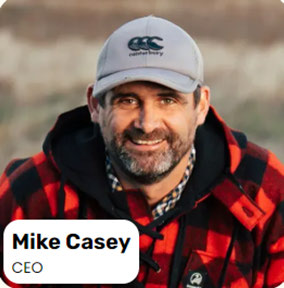
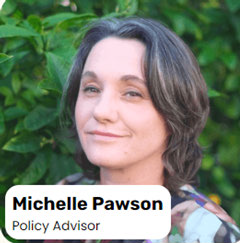
 Annex One: Attendees’ biographies
Mike Casey, Chief Executive Rewiring Aotearoa
Annex One: Attendees’ biographies
Mike Casey, Chief Executive Rewiring Aotearoa
Mike Casey is the owner of the world’s first zero fossil fuel
orchard located in Central Otago. He took up the role of
Chief Executive of Rewiring Aotearoa in 2023. Mike is
cofounder of NZ0.com where he sells zero emissions
cherries. He previously cofounded an online tech startup
community Fishburners and GradConnection in Sydney,
which was acquired by Seek.
Michelle Pawson, Policy Advisor Rewiring Aotearoa
the 1982
Michel e Pawson has worked for Rewiring Aotearoa since
August 2023. Prior to this, Michel e worked as a Public
Policy Fel ow at the Institute of Innovation and Public
Purpose at the University Col ege London. She has also
held Principal Advisor roles at the New Zealand
Act
Productivity Commission and the Ministry for the
Environment.
under
Josh Ellison, Research and Development Specialist
Rewiring Aotearoa
Josh El ison leads research, designing and development
work at Rewiring Aotearoa and Rewiring Australia. He
has co-authored Rewiring Australia’s research papers
Released
Information
and models since its establishment. He also works with
industry and communities to design and implement on the
ground electrification.
Official
No picture available
David Karl, Chief Operating Officer, Rewiring
Aotearoa
David Karl joined Rewiring Aotearoa in May 2024. David
has previous experience working in Government as a
Chief Advisor at the Ministry for the Environment, having
worked at the Ministry for over 14 years.
2324-2935
In Confidence
7
Annex Two: Suggested talking points
Energy in climate change policy
Suggested talking points:
I can assure you that the Government considers energy policy is a key tool to reduce
emissions and achieve our climate change targets.
The Second Emissions Reduction Plan is due at the end of this year. We wil be publicly
consulting on this plan shortly and I encourage you to participate.
Questions you may wish to ask:
How would you like to see the government providing strategic direction around
distributed energy resources within our climate change policy and Emissions Reduction
Plan?
Where in a household would you say the largest emissions reductions can come from?
the 1982
Rethinking assumptions about energy policy
Act
Questions you may wish to ask:
Has Rewiring Aotearoa undertaken analysis of the change in electricity networks’
under
requirements for investment, with increasing levels of DER? What would the impact of
this reduced network expenditure be on consumers’ bil s?
How do the costs of rooftop solar (plus batteries) compare to grid scale solar farms
(plus batteries) feeding into the grid?
Does the Australian experience of high rooftop solar penetration have any lessons for
New Zealand, in terms of risks as wel as advantages?
o
Has it reduced the investment needed from network owners to accommodate
electrification?
Released
Information
o
Are Australian governments stil promoting subsidised feed-in tariffs?
The Commerce Commission and the Electricity Authority have work programs and
regulatory initiatives underway to promote greater use of DER – what are your
reservations about their approaches?
Official
2324-2935
In Confidence
8
Financing for DER
Suggested talking points with regards to financing:
In general, the Government is of the view that households and business should
determine for themselves how to reduce emissions, rather than us dictating particular
technology options.
Questions you may wish to ask with regards to financing:
What sort of responses have you received from commercial sources of finance to your
proposals for residential and smal businesses?
In your recent Electric Farms report, you cal ed for the development of farm-focused
finance for electrification, and I understand that you raised this with farmers at the
recent Mystery Creek Field Day. What sort of response did you get from farmers and
the 1982
from people who provide finance for farms?
Suggested talking points with regards to standards:
I am aware of the electrical safety standards issue and there is work underway to both
Act
update the regulations and make it easier for new standards to be adopted in future. I
expect to be able to announce further details about this later this year. This includes the
solar inverter safety standard.
under
Question you may wish to ask with regards to standards:
Are there any other technical regulations related to instal ation of DER that need
consideration?
Released
Information
Official
2324-2935
In Confidence
9
Annex Three: Letter from Rewiring Aotearoa
the 1982
Act
under
Released
Information
Official
2324-2935
In Confidence
10

Tuesday 7th May 2024
Dear Minister Brown
Purpose
As requested by your office below is an overview of what we would like to discuss with you
in our Thursday 27 June 2024 meeting.
Key objectives
Some of the Rewiring team attended the Tuesday 30th April 2024 Electricity Networks
Aotearoa and Energy Retailers’ Association of NZ event. We heard Ministers speak to a
vision for New Zealand's energy future based largely on scaling up supply-side solutions.
We have concerns this thinking relies on energy and economic assumptions that we think
are outdated and need to be revisited. Using updated assumptions that more realistically
represent the demand side, or distributed energy, unlocks a yet to be considered cost of
the 1982
living reduction and energy resilience opportunity, and avoids unnecessary investment debt.
The energy transition is happening now. It is critical the Government provides strategic
direction and directs regulatory and policy settings so that customers, communities,
businesses and farms can fully realise this opportunity - electrification and distributed energy
Act
are a real win-win-win that ensures cost savings, improves energy security and resilience
while also delivering emissions reductions.
under
Now is the time to seize this opportunity to electrify our economy with existing technology,
which is the biggest emissions reduction and counter-inflationary investment opportunity for
the Government and country for the next three to five years. The country could vastly
improve our energy productivity and go from importing $20 billion1 worth of some of the
world's most expensive fossil fuels per year to saving billions and reducing emissions by
instead using locally produced electricity in more productive, effective homes, businesses,
farms and industries. We would like to discuss the following:
1. Costs savings, improved energy security and resilience, and emissions reductions
can be achieved by making energy a core climate change issue
Information
2. Rethinking the energy and economic assumptions NZ is using as shown in the
Released
‘Electric Homes’ report2: energy produced by customers on their roofs is now the
cheapest energy in NZ
3. Opportunities to ‘fix the finance’: Every home and farm financed into solar and
batteries removes them from peak, greatly increasing NZ’s energy security.
Next steps
We are keen to discuss the above issues with you, and our recent ‘Electric Homes’ report -
Official
https://www.rewiring.nz/electric-homes-report.
Regards
Mike Casey
CEO Rewiring Aotearoa
1 Refer Appendix, page 3, for calculations
2 https://www.rewiring.nz/electric-homes-report
1
Appendix - Recent advice provided to Minister Watts on what Rewiring Aotearoa
think needs to be done to unlock the decarbonisation via electrification in NZ
What needs to be done
Ensuring a level ‘playing field’ from a regulatory and legislative perspective requires
Government to:
A. Ask the Office of the Auditor General to examine whether the Electricity Authority and
Commerce Commission are meeting their statutory obligations in the energy sector
with regards to competition, reliability and efficiency, specifically with respect to
customer resources being able to compete with supply-side resources.
B. Direct MBIE to review the Electricity Act 1992 to ensure the interests of consumers
who may export electricity to the network are enabled and protected.
C. Direct the Electricity Authority (EA) to use its powers under section 32(1) of the
Electricity Industry Act (EI Act) to ensure adequate settings for cost-reflective pricing
(including incentives for customers to provide services back to the system): where
the
the Authority may set Code requirements that are necessary or desirable to promote
1982
one or more of its statutory objectives, the performance of its functions, and/or any
other matter specifically referred to in the EI Act as a matter for inclusion in the Code.
This includes under section 32(4) of the EI Act: "20.2 setting pricing methodologies
for Transpower or one or more electricity distributors”.
Act
D. Direct the Commerce Commission to give relevant Ministers and customers public
assurance that the current Part 4 incentive framework for electricity distribution
under
businesses (EDBs) avoids the risk that infrastructure will be overbuilt and properly
accounts for their move to cost-reflective pricing.
Fixing the Finance requires:
E. Direct the Reserve Bank of NZ to examine what it sees as the barriers and
opportunities for improving accessibility of lending to support the domestic
electrification (or the distributed energy transition).
Making it easier for households to install customer energy resources requires the
Government to:Released
Information
F. Direct MBIE and other agencies to comprehensively review and streamline
decade-old standards (e.g. Electrical (Safety) Regulations 2010) and regulations
relating to the installation of customer energy resources.
G. Support demonstration projects of community-generated or demand-side
electrification via the Regional Development Fund.
NZ needs to focus on the win-wins - using electrification to reduce emissions and
Official
reducing the cost-of-living burden at the same time
As our recent ‘Electric Homes’ Report demonstrated, electrification is the lowest cost
pathway to a net zero carbon economy. It will not only save the government money on
investing in poles and wires, but a key point is that this transition can be made right now
using existing technology in people's homes, businesses and farms. This means we can
move with pace and scale up quickly if the right conditions are created.
2
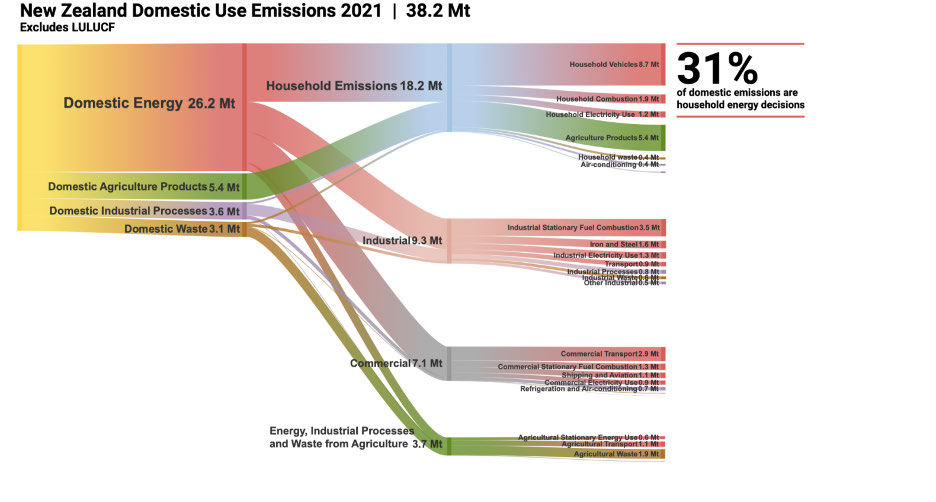
Decisions made by households account for 31% of emissions in our domestic economy, and
are an underappreciated opportunity for the country to reduce emissions.
the 1982
Act
We recently ran the numbers to understand the scale of NZ’s fossil fuel energy consumption
- in 2023 New Zealand consumed about 101 Petajoules (PJ) of Petrol, and 146 PJ of Diesel,
under
most of which were either imported, or refined from imported oil.3 At retail prices seen at the
pump, this equates to about $7.6 billion in petrol, and $8.5 billion in diesel.4 Retail prices
have increased significantly this year and are expected to keep rising.
A further 66.8 PJ of Natural Gas is consumed, and another 46.7 PJ used for energy
transformation - mostly to generate electricity. Adjusting for consumption at different prices
for industrial, commercial, and residential use, this is about $2 billion of Natural Gas
purchases per year by New Zealand homes and businesses.
9.66 PJ of LPG (Liquified Petroleum Gas) is consumed, at retail prices worth about $650
Information
million. 42.7 PJ of coal is consumed, mostly for industrial heat and electricity production.
Released
Another 57.4 PJ of aviation fuel is imported, with 39 PJ used for international flights and 18
PJ used for domestic flights, totalling around $1.7 billion. Combined this is around $20 billion
worth of fossil fuels per year.
To meet our international climate obligations, NZ needs to move away from relying on
increasingly expensive carbon offsets and focus on reducing emissions through
electrification. As the price of solar and batteries continues to drop, it’s important to
Official
recognise that the cheapest renewable energy will come from rooftops and batteries - and
the second cheapest will likely come from neighbours’ rooftops and batteries.
3https://www.mbie.govt.nz/building-and-energy/energy-and-natural-resources/energy-statistics-and-modelling/energy-statistics/oil-statistics/
4https://www.mbie.govt.nz/building-and-energy/energy-and-natural-resources/energy-statistics-and-modelling/energy-statistics/energy-prices/
3
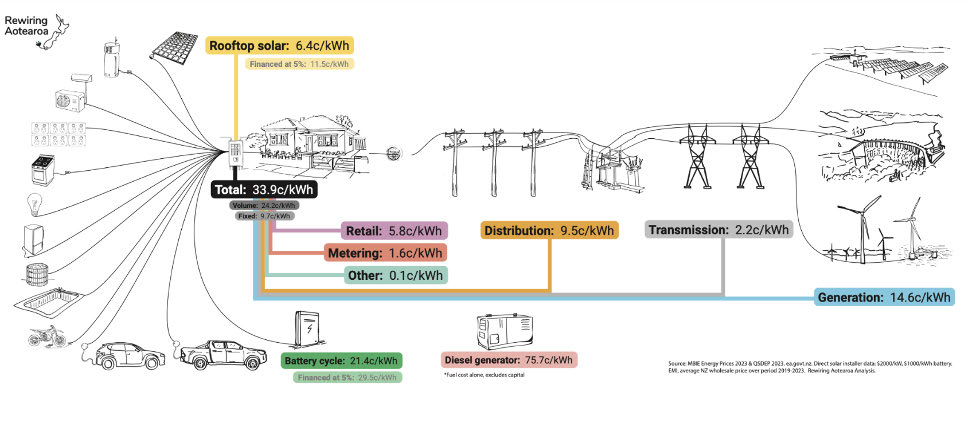
New Zealand can no longer look at climate change solutions as a cost problem. It must
make the investment in customer generated energy. What we know is climate solutions don't
the 1982
cost more, but delaying implementation of the decarbonisation opportunity that electrification
presents will cost the economy for generations to come.
As we have outlined previously, part of this is ensuring the energy system values customer
Act
generation and understands the cheapest delivered energy will come from communities.
under
Ensuring the electricity market ‘playing field’ is level, allowing competition between
customers and large-scale generators:
A core characteristic of the future electricity system, one that strikes the best tradeoff
between affordability, resilience and decarbonisation, needs to be that households and
businesses become part of and are rewarded for the part they play as system infrastructure,
and only pay for the legitimate extra costs (or constraints) they impose on the system.
New Zealand’s electricity market design has been based on the philosophy that competitive
markets, with appropriate ‘rules of the game’, will deliver the lowest cost system to the
customer.
Released
Information
Acknowledging that NZ will need some grid-scale renewable generation to meet the needs
of large commercial and industrial consumers, our analysis shows that customer-generated
energy (rooftop solar and batteries) will be a significant part of the lowest-cost pathway to
the cheapest, cleanest and most reliable energy system. However, at present there is not a
level playing field between customer resources and grid-scale resources, and hence, we are
not delivering effective competition. Electricity prices - and, therefore, the cost of electrifying
Official
homes and businesses - will remain above what they should be until we deliver a truly
competitive market.
As discussed previously, the key issue here is today the electricity market is neither fair nor
cost reflective. A battery in a consumer garage is a competitor, but the regulatory playing
field is not level for all competition. The electricity market is not working as well as it could,
and is currently penalising customers.
4
This situation has snuck up on us as a country; when the market was designed in the 1990s,
and for the majority of the 25 years since, customer resources (such as rooftop solar) have
been substantially more expensive than large-scale, grid-based generation. This is no
longer the situation today, and we are left with a set of regulations, standards and market
practices that are outdated.
A solar panel on a household rooftop in Wellington should be able to compete in the market
with a hydro generator in the Waitaki. A battery in a cupboard that can provide energy should
compete in the market with a network line upgrade. And if it is cheaper to install and provide
the service required by the system, the battery should ‘win’.
At the moment, the market is not set up for this degree of competition. Despite customer
resources being able to provide the same, or very similar service to large-scale
infrastructure, these resources can’t always access the market and the revenue streams that
the market provides.
the 1982
But the Government could smarten up the rules to allow it to happen. Customers need to
have the choice of retail tariff options which are ‘cost and value reflective’, which includes
paying customers fairly for their contributions to the energy system - contributions which
reduce the need for more expensive generation, and help defer or avoid expensive network
Act
upgrades.
under
New Zealand is falling behind international progress on tariffs. This is most acute in the
arena of network pricing, which is under the control of EDBs (and passed through to
retailers). The Electricity Authority has publicly reported that progress towards cost-reflective
tariffs has been slow, especially where households and businesses are providing services
back to the electricity system.
Yet this is unsurprising, because there is no piece of electricity industry code or regulation
that requires EDBs to adopt ‘cost reflective pricing’. However, despite the Authority having
the power under the Electricity Act to introduce standards for pricing, it appears to be
reluctant to move quickly and be directive about the outcome that is in the best interests of
Information
consumers.
Released
However, today, the incentives on EDBs to genuinely consider customer resources as a way
of deferring or avoiding the need to build new lines are relatively weak. Further, when
making their case for investment to the Commerce Commission, we believe EDBs have
underestimated the speed at which customer resources - especially batteries - will be
deployed. This is closely linked to EDBs reluctance to pay customers for well-time export
from collar and battery systems. Again, this appears to be a failure of the market design. If
Official
batteries were rewarded appropriately for their ability to defer or avoid infrastructure, the
incentives for customers to invest in batteries would improve, more batteries would become
available, and less infrastructure would be required.
Without these incentives, and the skewed incentives faced by EDBs to anticipate future
increases in customer resources, there is a high risk that EDBs, at the expense of the
consumer, begin building infrastructure for a future that never eventuated. The only way we
5
can reduce these costs for the customer is to efficiently defer or avoid those investments
(dynamic efficiency). Once they are built the customer pays.
Data democratisation is another issue NZ has lagged behind on, our systems for making
customer data available to customers, as well as other third parties who could use it to
improve asset management and innovate. For example, under current regulations, a
customer will have to wait up to 5 days to get their own smart meter data from their retailer.
And there is no requirement to provide the full smart meter dataset, and/or in a form that is
usable by the customer (e.g., a spreadsheet). These regulations are out of sync with the rest
of the world and are stymying innovation in the sector.
Solving climate change doesn’t necessarily need to be a future burden. With smart
regulation and incentives in place, it can be an opportunity to change behaviour, reduce
domestic emissions and create economic growth by scaling up industries. But as identified
above there are ‘pre-conditions’ this Government can realise now to enable a distributed
energy system that does not penalise customers, and levels the playing field.
the 1982
As previously noted, we have recently raised concern about whether the Electricity Authority
(EA) and Commerce Commission are meeting their statutory obligations5, as it is clear that
the objectives of both the EA and Commission is to provide a competitive, fair and
Act
cost-reflective electricity market for consumers.under
Fixing the finance
As Australian inventor and founder of Rewiring America and Rewiring Australia Dr Saul
Griffith says, climate change is basically a machines problem and to solve it we need to find
a way to swap fuel for finance. Rather than pay for subsidies (like the previous
Government’s Clean Car Discount) we are currently exploring innovations in how the
Government could facilitate finance so public money could be put to use to achieve public
good outcomes, simultaneously addressing cost of living pressures and reducing carbon
emissions.
In Australia, the Government is exploring an ‘Electrify Everything’ loan scheme where the
Information
cost of electrification can be tied to property contingent loans and debt can be slowly paid off
Released
or paid off in full when the property sells. That means that it should also appeal to landlords,
climate action can be funded with future capital gains and it will be low-cost for the
Government as the funds are repaid.
We believe there is a golden opportunity for this Government to develop a cost-of-living
reduction policy based on providing access to electrification that also significantly reduces
the country’s emissions. This will require a focus on developing financial mechanisms that
Official
will allow New Zealanders of all income levels and home ownership situations to pay the
upfront capital costs associated with electric machines, swap fuel for finance and access the
5
Statutory objective of the EA: (Section 15, of the Electricity Industry Act 2010)
: “To promote
competition in, reliable supply
by, and the
efficient operation of, the electricity industry for the
long-term benefit of consumers”. Additional objective is "
to
protect the interests of domestic consumers and small business consumers in relation to the supply of electricity to
those consumers”
Objectives of Commerce Commission: “consumers are protected, and clear and accurate information is provided to them;
there is a
level playing field for competitors – the rules are known and players are monitored… poor, misleading or
unbalanced information affecting competition in the market is addressed;
regulated businesses face incentives to provide
long-term benefits for consumers.”
6
long-term savings. While finance itself is important, removing regulatory and other barriers to
novel (to New Zealand in this context) financing mechanisms such as on-bill finance and
property contingent loans will also be important.
Testing this finance thinking in demonstration projects of community electrification in places
like Rakiura / Stewart Island and Pacific Islands like Tokelau will help create a model that
can be rolled out nationally and across the Pacific, creating long-term cost savings for
energy users, reducing emissions and creating a more resilient energy system.
Making it easier for households to install consumer energy resources
There is also a lot of clumsy regulation and standards when it comes to installation of solar
and batteries. This increases the cost to New Zealanders of installing their own generation
and storage resources.
Standardisation and some regulatory changes would help to address these issues. These
actions have been on the industry work plan for years but very little progress has been
the 1982
made. Australia offers a wonderful blueprint for how this can happen; solar installation
efficiencies were brought about 15 years ago, and now Australia boasts the lowest cost
rooftop solar in the world (even removing the effect of subsidies).
Act
under
Released
Information
Official
7
Excerpts from Briefings and Weekly Reports
Excerpts from Weekly Report entries 4 March - 19 August 2024
Weekly report week of 4 March 2024:
the 1982
Report on solarZero winter peak trial
A new report highlights the role for distributed energy resources
Tamara Linnhoff
(DER), such as household solar and bafteries, to help manage
s 9(2)(a)
security of supply risk during winter peaks.
Ara Ake part-funded last year’s eight-month trial of solarZero’s
Act
aggregafion of 10,000 home bafteries - stored power which was
used to feed back onto the grid in response to fight supply
under
events, when nofified by the System Operator. The Electricity
Authority also played a crifical role in enabling the trial.
When called on, solarZero contributed supply deemed significant
by both the System Operator and Authority (e.g., tests saw
26.5MW discharged over 2 hours, and solarZero was able to
demonstrate capacity of up to 30MW). The report highlighted a
number of technical and market considerafions needed to
support this and other new services potenfially enabled by DER.
Weekly report week of 18 March 2024:
The Electrified
Two versions of the report are being published on 18 March:
Information
Home report by
Released
• a technical report (published by EECA, with contribufing
Rewiring Aotearoa
acknowledgments)
Scoft Russell
• a full policy-focused report with Rewiring Aotearoa’s own
s 9(2)(a)
analysis and
recommendafions (published by them, which will include the
technical report and
findings).
Official
The technical report models the cost, efficiency, and emissions
impact of household
electrificafion both at a household and nafional level across three
key investment appliances,
plus electric vehicles and solar (with and without bafteries). It
shows it can be cheaper to run
an electric household than use fossil fuels on lifecycle basis.
While average consumer bills are expected to increase over the
the 1982
coming years, the technical
report suggests petrol and gas homes that electrify their
appliances can receive significant
long-term relief – with esfimated household savings of over
$1,000 per year (or $4,000 if
Act
supported by low-interest loans).
Household electrificafion is also likely to support a smarter and
under
more responsive electricity
system – helping drive the uptake of flexible devices like EVs and
home bafteries, which can
help shift peak load and reduce the need for costly network
investment.
Rewiring Aotearoa is an independent registered charity working
on energy, climate, and
electrificafion research and advocacy. EECA part-funded the
technical analysis in line with its
mandate to promote energy efficiency and renewable energy,
including through research
Information
and informafion provision. EECA was not involved in the policy
Released
report and will not endorse
any recommendafions.
Official
Weekly report week of 17 June 2024:
ERP2 – updates to Energy chapter
Out of scope
Scoft Russell
s 9(2)(a)
the 1982
Act
under
Feed-in-tariffs (FiT) for rooftop solar and baftery systems: Feed-
in-tariffs could be effecfive in enhancing uptake of household
systems, and the Authority plans to consult on potenfial
amendments to the Code to support FiT shortly. We will add
some addifional detail to the chapter in relafion to a smart
electricity system, including seeking feedback on opfions for
progressing a smarter electricity system more broadly.
Out of scope
Information
Released
Out of scope
Official
Out of scope
the 1982
Act
under
Consumer Data Right
As previously menfioned to you, officials have been conducfing
Scoft Russell
targeted engagement with key stakeholders in the electricity
s 9(2)(a)
sector regarding a potenfial electricity CDR designafion. This
targeted engagement will inform our preparafion of policy
papers and a public discussion document.
We have so far met with the following stakeholders:
Retailers: s 9(2)(ba)(i)
Released
Information
Lines companies: s 9(2)(ba)(i)
Consumer agencies and advocates: s 9(2)(ba)(i)
Flexibility and innovafive organisafions: s 9(2)(ba)(i)
Official
Metering Equipment Providers: s 9(2)(ba)(i)
We have also been engaging with relevant government agencies,
such as the Office of the Privacy Commissioner, and our
counterparts in the Australian Treasury.
Some of the key themes from targeted engagement so far have
included:
the 1982
A CDR for the electricity sector could potenfial y deliver
significant benefits to consumers, parficularly in helping them
find the best electricity plan for their circumstances more easily,
more quickly and with more confidence. Unlocking half hourly
consumpfion data and retail tariff data appears to be where the
Act
most gains could be made.
Befter data access and provision could also enable consumers
under
to make more informed decisions regarding electrificafion e.g.
purchasing an EV or solar PV for their household. It could also
help more generally with household energy management.
A CDR will not solve every issue – for example, consumer
advocates thought that a CDR could help some households,
however complementary measures are required parficularly for
those struggling with energy affordability.
For regulated stakeholders such as retailers it is will be
important to clarify how a CDR regime would interact with the
Electricity Industry Parficipafion Code 2010 (Code) that the
Authority administers.
Information
Sector readiness for implemenfing a CDR appears to be variable
Released
and implementafion costs could potenfial y be high.
We are confinuing to work closely with the Electricity Authority
as we progress this CDR work, and they progress their data work
programme.
Official
We have planned a few more targeted engagements, including
with other government agencies and wil begin drafting a
discussion document for consultafion. We are also working with
our Commerce and Consumer Affairs colleagues to coordinate
the respecfive fimelines for consulfing on electricity and banking
designafion discussion documents.
the 1982
Weekly report week of 12 August 2024:
Act
Review of the voltage range
We are reviewing whether a wider range of voltages should be
Tamara Linnhoff
allowed on low voltage networks (lines supplying households and
s 9(2)(a)
under
businesses). This would align with some Australian states.
Research is underway into the potenfial limitafions that voltage
regulafions could place on distributed generafion, like rooftop
solar. We are on track to provide a draft discussion document,
briefing and cabinet paper in early September, as per the Energy
Output Plan.
Weekly report week of 19 August 2024:
Further NZGIF investment in solarZero’s
Media have reported this week that solarZero has now secured a
Released
Information
Scoft Russell
total of $365m of debt finance through the government’s New
s 9(2)(a)
Zealand Green Investment Finance Limited (NZGIF). The debt
facility iexpansion comes from parficipafion by European
investment firm, Societe Generale.
This will finance solarZero’s business expansion of owning more
Distributed Energy Resources (DER) on rooftops of homes. We
Official
understand solarZero will use that funding to extend their
offering to approximately 20,000 households.
The business model involves offering households long term
contracts (25 years) to buy power generated from solar and
baftery systems installed on their property, but owned by
solarZero. The solar systems cost nothing to the household
upfront, but the contract gives households a fixed monthly fee
for their solar consumpfion, and access to a retail plan for any
the 1982
addifional consumpfion required.
Excerpt From Briefing 2425 – 0611: ERP2 – Submissions analysis and proposed approach to developing final ERP2
content 5 September 2024
Act
Annex One: Summary of energy stakeholder submissions
under
Demand side
Feedback on high level approach
s 9(2)(f)(iv)
From Briefing 2425 – 0984: Delivering energy security of supply and cost savings through energy efficiency and
demand-side measures
13 September 2024
Information
Released
Recommended acfion
c. Indicate which of the following
potential new levers, if any, you would like us to prepare further advice on, noting they have financial
implications and would take longer to implement:
Innovative loan or financing facilities to
Yes / No
increase the uptake of solar PV and/or battery
Official
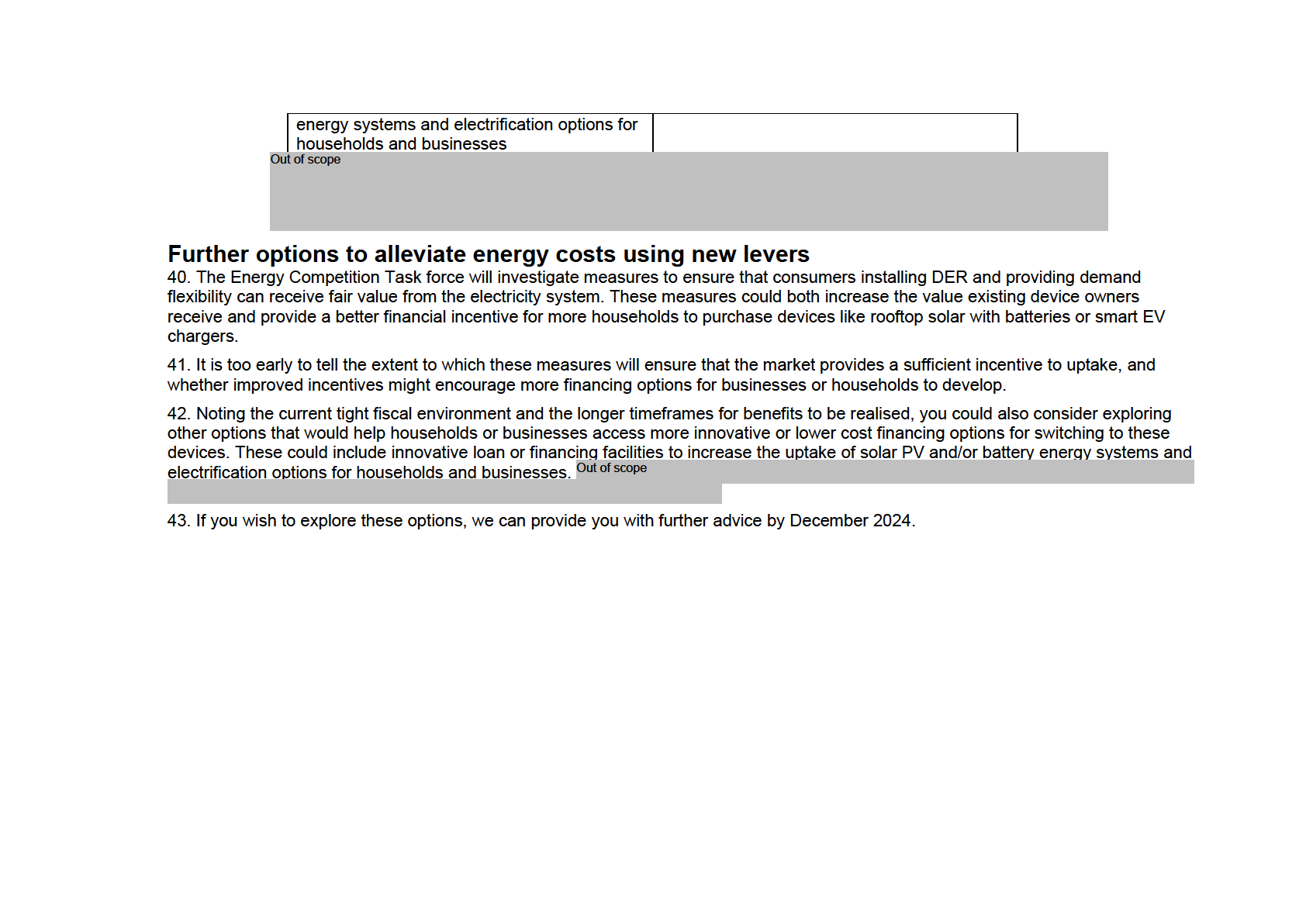
the 1982
Act
under
Released
Information
Official
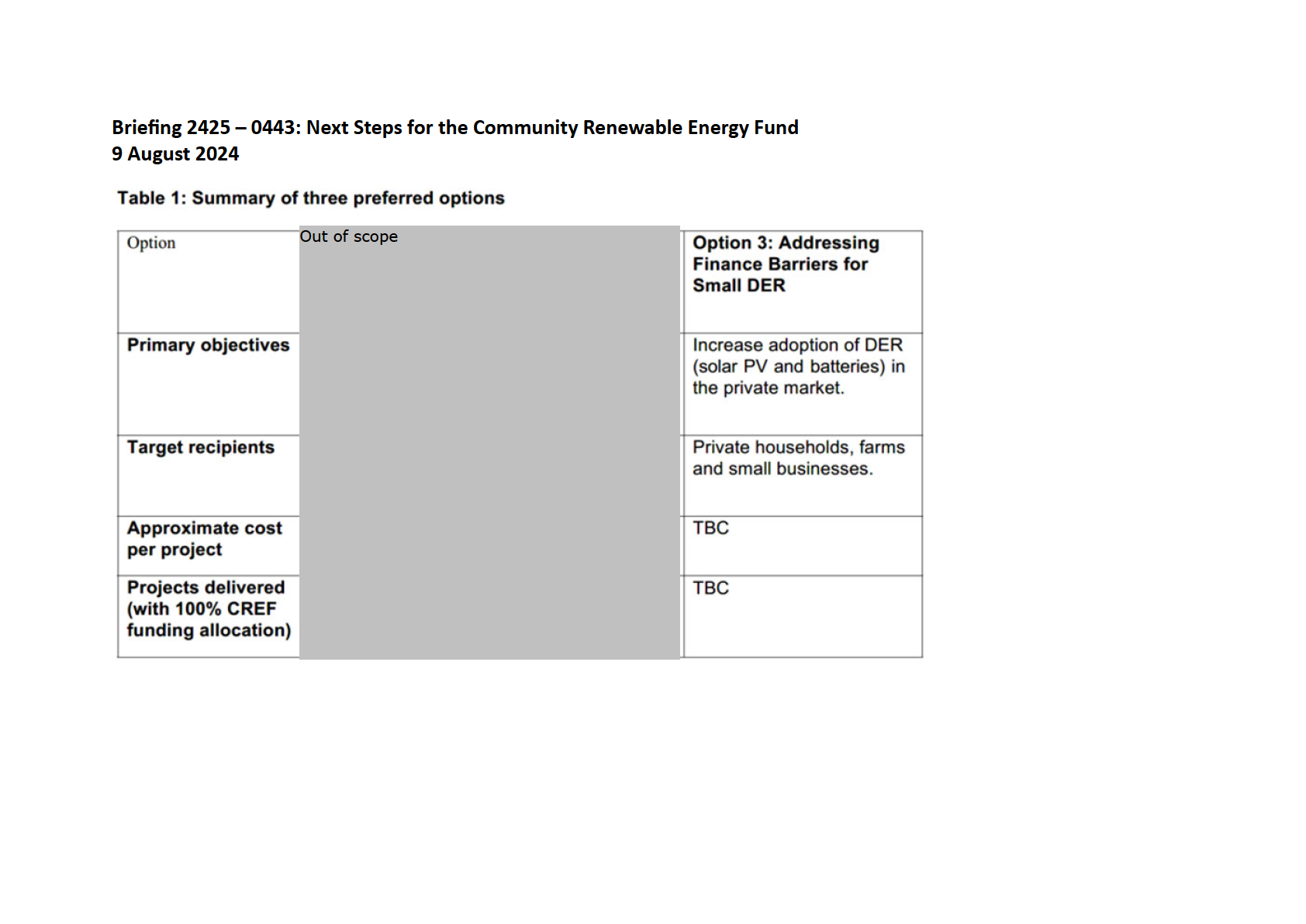
the 1982
Act
under
Released
Information
Official
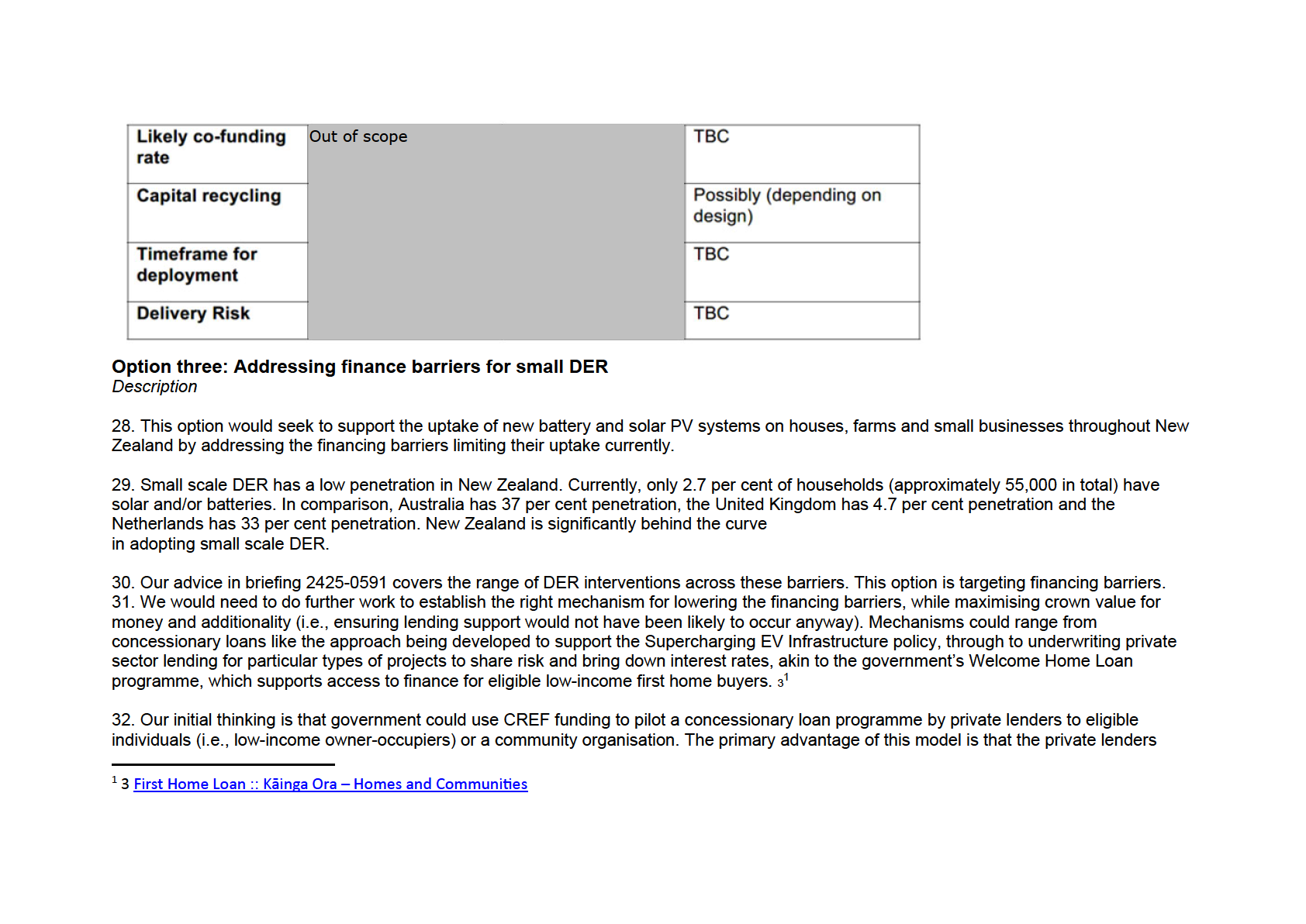
the 1982
Act
under
Released
Information
Official
provide all or a majority of the capital, are appropriately incentivised to manage credit risk and manage the loans on their books. A longer-term
benefit of this option is that it would provide lessons for the finance sector and build familiarity with lending on these types of
assets.
33. This option would take more time to scope and implement and would also require changes to the appropriation, which may require Cabinet
decisions. We have considered this option as it has potential to unlock more market transformation and widespread impact than the others.
Intervention logic / assessment of the option
the
34. By supporting access to low interest finance, households, smal businesses and farms can access financial y viable finance to adopt smal
1982
scale DER. Those with solar PV and batteries would have significantly cheaper power bil s, be resilient to emergencies and be able to sell
excess generated electricity to the grid at peak times.
35. Technical analysis by Rewiring Aotearoa has estimated that with rooftop solar at 5.5% finance, the delivered energy cost for a home could
Act
be $0.12/kWh compared to $0.34/kWh (using the grid average). With a 0% interest rate this could drop even lower to $0.06/kWh.
36. The economics appear to support many households, SMEs and farms adopting solar PV over continued reliance on grid electricity, other
under
barriers appear to be limiting uptake, one of which is suitable access to finance [briefing 2425-0591 refers]. Finance barriers wil be more acute
for low-income owner-occupiers who would benefit most from access to lower cost electricity.
37. Commercial banks have begun some limited lending in this space, though the range of products available are limited (most offer low
interest for only 3 - 5 years at most). It is not clear how well aligned they are with payback horizons of the assets or the needs of low-income
households that would benefit most from lower electricity bil s.
38. Additionally, most existing solar PV installations and most new residential solar PV installations do not include batteries. Batteries can
reduce congestion, defer network investment and increase resilience. However, batteries are costly and have long payback times. Without
suitable financing mechanisms to spread the cost over their lifetimes most households wil struggle to justify investing in batteries.
39. This option requires the majority of investment to come from private sources and is a clear pathway for integrating private investment into
Released
Information
emissions reduction opportunities.
Official
 BRIEFING
BRIEFING
Consultation on proposed amendments to the Electricity (Safety)
Regulations to expand the permitted voltage range for electricity supply
Date:
13 September 2024
Priority:
Medium
Security classification: Unclassified
Tracking number: 2425-0910
Action sought
Action sought
Deadline
Hon Simeon Brown
Note that amending the permitted voltage range could
19 September
Minister for
defer or reduce network investment and support solar PV
2024
Energy
uptake
the
Note the proposed increase in upper voltage limit is
1982
considered low risk, would be consistent with existing
standards for appliances, and would align with Australia
Agree to begin ministerial and departmental consultation
Act
on the attached Cabinet paper (Annex One) and discussion
document (Annex Two) under
Forward to the Minister for Workplace Relations and
Safety
Contact for telephone discussion (if required)
Name
Position
Telephone
1st contact
Tamara Linnhoff Manager, Electricity Markets Policy
s 9(2)(a)
Gareth Wilson
Strategic Advisor, Electricity Markets Policy
Ed Smith
Principal Advisor, Electricity Markets Policy
04 901 8248
Information
Released
The following departments/agencies have been consulted
The attached discussion document was prepared by MBIE with input from the Electricity
Authority, Energy Efficiency and Conservation Authority, and WorkSafe New Zealand. We are
currently consulting with the Treasury and Ministry for the Environment. The Department of the
Prime Minister and Cabinet have been informed.
Minister’s office to complete:
Approved
Declined
Official
Noted
Needs change
Seen
Overtaken by Events
See Minister’s Notes
Withdrawn
Comments
 BRIEFING
BRIEFING
Consultation on proposed amendments to the Electricity (Safety)
Regulations to expand the permitted voltage range for electricity supply
Date:
13 September 2024
Priority:
Medium
Security classification: Unclassified
Tracking number: 2425-0910
Purpose
This briefing seeks your approval to begin ministerial and departmental consultation on a Cabinet
paper seeking agreement to consult on a proposed amendment to the Electricity (Safety)
Regulations 2010 to widen the permitted voltage range for electricity supply on low voltage
electricity networks.
A draft cabinet paper is at
Annex One, and a discussion document at
Annex Two.
the 1982
Executive summary
Most homes and businesses connect to the electricity system through low voltage distribution
networks. The Electricity (Safety) Regulations 2010 require low voltage electricity to be supplied
Act
within six per cent of 230 Volts.
Uptake of distributed energy resources (DER) including solar photovoltaic panels (solar PV) is, and
under
expected to continue, increasing. To keep voltage within the regulated limit of six per cent above or
below the specified level, networks may need to curtail the use of DER or invest in significant
network upgrades.
We propose to expand New Zealand’s regulated voltage range: from 230 Volts plus or minus six
per cent, to align with Australia’s wider voltage range (230 Volts plus 10 and minus six per cent).
This should enable a significant increase in peak output from DER including rooftop solar PV,
without requiring additional network expenditure.
The proposed wider voltage range is considered low risk. New Zealand’s appliance standards have
been aligned with international standards for many years, including designing for voltage ranges of
230 Volts plus or minus 10 per cent. It is also possible that older appliances can tolerate higher
Information
voltages, as they are likely to have been designed to accommodate the higher nominal voltage of
Released
240 Volts that was historical y used in parts of Australia.
However, there is a risk that allowing higher or lower voltage could result in some appliances
depreciating or failing prematurely, leading to inconvenience, replacement costs and potential y
harm to consumers. We expect consultation on the proposal to enable a better assessment of the
potential size of such risks.
Subject to feedback from the consultation and your approval, we wil draft policy proposals and the
Official
necessary amendments to the Electricity (Safety) Regulations in preparation for a final Cabinet
decision in February 2025, in line with your Ministerial Priorities Output Plan.
2425-0910
Unclassified
1
Recommended action
The Ministry of Business, Innovation and Employment recommends that you:
a.
Note that amending the permitted voltage range could defer or reduce network investment and
support solar PV uptake
Noted
b.
Note the proposed increase in upper voltage limit is considered low risk, would be consistent
with existing standards for appliances, and would align with Australia
Noted
c.
Agree to begin ministerial and departmental consultation on the attached Cabinet paper
(Annex One) and discussion document (Annex Two)
Agree / Disagree
d.
Forward to the Minister for Workplace Relations and Safety
Forwarded
the 1982
Act
under
Tamara Linnhoff
Manager, Electricity Generation,
Hon Simeon Brown
Infrastructure and Markets Policy
Minister for Energy
Energy branch, MBIE
13 / 09 / 2024
..... / ...... / ......
Released
Information
Official
2425-0910
Unclassified
2
Additional infrastructure expenditure, or rooftop solar curtailment, may
be required in future to keep voltage within the regulated range
Homes and businesses get power through low voltage networks
1.
Most homes and businesses connect to the electricity system through low voltage distribution
networks. The power they supply is sometimes cal ed ‘mains supply’.
2.
Most electricity is generated by large power stations connected to Transpower’s high voltage
transmission network. High voltages in Transpower’s national transmission network al ow
large amounts of electricity to be transported over long distances with minimal losses. Lower
voltages in sub-transmission and distribution networks al ow electricity to be safely
transported to homes and businesses, and at each point of supply, the low supply voltage
enables electricity to be used by a wide variety of electrical appliances.
Current regulations require voltages remain within a tight +/- six per cent range
3.
Current regulations require low voltage electricity to be supplied at a nominal voltage of 230
Volts, and except for momentary fluctuations must be kept within six per cent of that nominal
the 1982
voltage. It is not easy to maintain a very specific voltage at every supply as changes in
demand decrease voltage and generation increases it (all other things being equal). New
Zealand’s tight voltage range is now an outlier compared to most international counterparts.
The demands on low voltage networks are changing
Act
4.
The demands on low voltage networks as more homes and businesses are investing in
rooftop solar PV generation and electric vehicles (EVs) – collectively termed DER. The
under
uptake of DER is expected to accelerate in the years ahead as the costs of these resources
fall and their performance improves. Electricity consumption may also increase as homes
and business switch from using natural gas to electricity to heat their properties and hot
water.
5.
Large amounts of solar PV could raise voltage above the regulated range (overvoltage) if it
coincides with low household demand. Similarly, many EVs charging during high demand
could result in voltage on networks fal ing below the regulated minimum (undervoltage).
Other things being equal, distribution networks would either need to curtail the utilisation of
distributed energy resources or spend significant sums on network upgrades.
Information
We propose consulting on modernising the regulated voltage range
Released
We propose increasing the upper voltage limit to +10 per cent to allow increased
peak output from solar PV, without additional network expenditure
6.
We have investigated the potential benefits and costs of increasing the regulated supply
voltage range. The discussion document notes that increasing the upper voltage limit from +6
to +10 per cent would:
Official
a.
align New Zealand’s supply voltage range with that in Australia, giving consumers
confidence that appliances designed for one market wil also operate effectively in the
other
b.
be consistent with existing standards that have required appliances sold in New
Zealand to be able to operate safely and efficiently at voltages in the range -10 to +10
per cent for several years
c.
enable a significant increase in peak output from solar PV installed in homes and
businesses, without needing additional network expenditure.
2425-0910
Unclassified
3
We do not recommend decreasing the lower voltage limit as the benefits are less
clear
7.
The discussion document explains that reducing the lower voltage limit from -6 to -10 per
cent could potential y avoid or defer network expenditure if low voltage were to constrain
charging EVs at peak times.
8.
However, this approach is not recommended as expert advice is that transformer thermal
limits, rather than low voltage limits, are expected to be the binding constraint on peak
demand in most networks.
The risks of appliances failing following an expanded voltage range should be low
9.
Appliances are designed and optimised for a certain input voltage. New Zealand’s appliance
standards have been aligned with international standards for many years, including the wider
voltage ranges permitted in Australia and Europe. It is therefore likely that newer appliances
sold in New Zealand are designed for a greater voltage range of ±10%.
10. It is also possible that older appliances can tolerate higher voltages, as they are likely to
have been designed to accommodate the higher nominal voltage of 240 Volts that was
the
historically used in parts of Australia.
1982
11. However, there is a risk that allowing higher or lower voltage could result in some appliances
depreciating or failing prematurely, resulting is costs, inconvenience, and potentially harm to
consumers. The main purpose of the proposed discussion paper is to seek evidence of the
Act
risks to appliances, so we can properly assess the cost and safety implications of any
changes on households or businesses.
under
12. The discussion document also seeks views on options for how changes to the voltage range
could be implemented. For example, whether there are any advantages in taking a phased
approach or if there are specific safeguards that should be introduced for higher risk
appliances, such as medical equipment.
Next steps
13. We have completed departmental consultation on the discussion document. Subject to your
approval we wil begin ministerial and departmental consultation on the draft Cabinet paper.
Due to recess, the next available Cabinet Economic Policy Committee meeting is on 16
October, ahead of a Cabinet meeting on 21 October. We wil therefore prepare to lodge the
Information
attached cabinet paper and discussion document in early October.
Released
14. We expect to publish for consultation towards the end of October. Then, subject to
consideration of feedback and your approval, we wil draft final proposed amendments to the
Electricity (Safety) Regulations ready for a final Cabinet decision in February 2025, in line
with your Ministerial Priorities Output Plan.
Annexes Official
Annex One: Draft Cabinet Paper - Consultation on proposed amendments to the Electricity
(Safety) Regulations to expand the permitted voltage range for electricity supply
Annex Two: Discussion Document - Amendments to the Electricity Safety Regulations to expand
the permitted voltage range for electricity supply
2425-0910
Unclassified
4
Annex One: Draft Cabinet Paper
Draft Cabinet paper withheld in full under 9(2)(g)(i)
the 1982
Act
under
Released
Information
Official
2425-0910
Unclassified
5




























